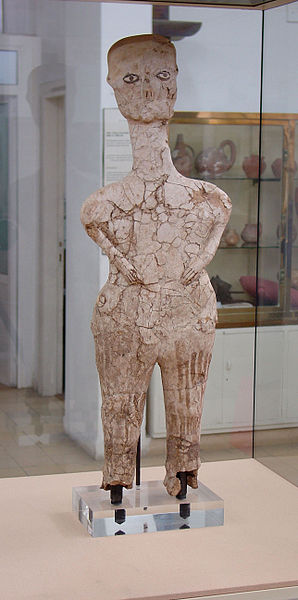

Ancestor Statues
Ain Ghazal
Later Pre-Pottery Neolithic B, 6700-6500 AD
Archaeological Museum
The Citadel, Amman, Jordan

|

|
Ancestor StatuesAin Ghazal
|
Approximately 30 of these enigmatic and appealing statues, ranging between 2 and 3 feet in height and looking rather like kindly extraterrestrials to modern eyes, were discovered in 1983 and 1985 during road construction on the outskirts of Amman (site report). The statues were loaned abroad for conservation and exhibit, some to the British Museum and others to the Smithsonian, before returning permanently to Jordan.
The statues are made of plaster applied to an interior reed armature. Some have legs, while others just have block torsos. They are most likely funeral statues, that commemorate deceased family members of important lineages. Their eyes, of whiter plaster than the rest of the body, are outlined with bitumen and traces of another, greenish, pigment; the pupils are also made of bitumen. Some statues show traces of paint on the body. Recessed crania, as in the photos above, indicate that the heads were once adorned with wigs or headdresses. Gender is usually not indicated. Some of the statues have two heads and joined bodies; they could have represented a husband and wife, or other pairs (siblings, parent/child, etc.) depending on circumstances.
When found, the statues had been deliberately buried underneath the floors of uninhabited houses, echoing the widespread neolithic practice of burying important family members (such as clan heads) under the floors of their own homes. The Jordanian statues were most likely fashioned for ancestor worship, painted and adorned, and revered in a special place by the community. When no longer needed or remembered, the figures were eventually disposed of by symbolic "reburial." Although it is difficult to prove such a theory, it is consistent with what is known about ancestor veneration in the Far East, Europe, and Africa.
Note: Pronounce "Ain" as in "rain."

|

|